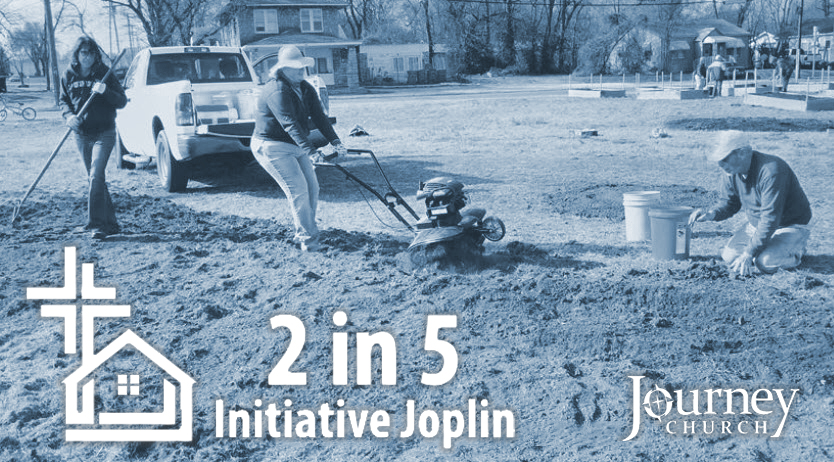Journey Church: a Congregation and Community Transformed

Nathan Mayo
Director of Member Services
Pastor John “Chip” Boyd recalls that prior to 2011, Journey Church’s ministry focus was almost 100% internal. With a small church of only 130 members, they did not expect to change their predominantly poor urban neighborhood in Joplin, Missouri. When a devastating tornado ripped through their town in 2011, they were jolted to consider how they could help their neighbors. This question was amplified by a Wisconsin-based missions company that used Journey as a platform for a short-term mission trip to assist with tornado rehabilitation.
When Journey Church members saw people coming from out of state to serve their own community, it was a clarion call to put their faith into action. The church refocused its ministry to spend 80% of their ministry time, energy, and dollars in their neighborhood. A wave of exhilaration swept through the church as members experienced the thrill of serving people in need. As the years went by, that exhilaration eroded into the fatigue of watching the same people with the same problems get the same “help.”
In 2017, Journey Church did some soul searching and determined a more deliberate way forward than their previous strategy of one-way handouts. They crafted a plan to reach every neighbor in a two-mile radius over the next five years—the “2 in 5 Initiative.” The plan was to offer some tailored assistance and friendship to each family with an intent to improve their long-term situation, as laid out in these steps:
1) Make their acquaintance.
This could be through an in-person invitation to an event, like a community Christmas dinner or to participate in a program, like a community garden. This also takes the form of identifying obvious needs, like a collapsing roof and stopping to ask if the church could be of assistance.
2) Assess their complete needs.
Once a church member or leader establishes a connection with the community member, they are asked to discuss deeper needs, using a brief assessment card as a prompt for conversation. If your roof is collapsing, there is sure to be a discussion of why you are unable to pay for your own roof. Is it inadequate income? Or inadequate management of existing income? Sometimes the needs are simple requests for relationship—“My husband is in prison, and I wish I had someone to play catch with my son.” Pastor John remarked that literally every community member he is aware of was willing to discuss underlying problems, if a church representative first established rapport and expressed a sincere desire to help. In his words, “If we want to really help people, we’re going to have to get into their business, and it is going to get messy.”
3) Match the needs of the community member with the assets of the church members.
For those needing better income streams, the church pairs them with members who teach resume writing and employment skills. For those needing assistance with money management, the church teaches budgeting. If they need home repairs, the church is happy to assist. If they need money to get them through a tight spot, the church offers members an interest-free loan—repayment is required for additional financial assistance. In short, the church is thrilled to offer people ways to better their own situation. However, the leadership team will ask tough questions and, for those uninterested in bettering their own lot, the church is friendly but refuses to enable bad choices. When a young couple came to request assistance with their electric bill days after spending their tax refund/credit on expensive electronics, Pastor John helped them return their new toys. They paid their own electric bill.
4) Follow up to ensure their needs were met.
To ensure that projects and classes have the intended effect, assigned church members follow up with beneficiaries monthly. They build lasting friendships when possible, and when not, they provide feedback to the church on how effective the assistance was and recommend additional assistance as needed.
5) Invite the community member to partner with the church in helping others.
The ultimate goal of charity is not to merely assist “the needy,” but rather to transform the needy into flourishing people and see them pass on the service they received. In the case of Journey Church, this begins with invitations to accept Christ and join the church. If people decline or already attend other churches, they are still encouraged to use Journey as a local hub and share the needs of neighbors with the church and join collective projects in support of their own community.
The 2 in 5 Initiative is ahead of schedule to meaningfully impact every family in a two-mile radius of the church. Pastor John also notes how incredibly generous their diverse-income church is at contributing to the church’s operation and outreach. John attributes this generosity to the fact that members know their dollars, time, and talents are really changing lives—not because of emotive advertising, but because of effective, challenging programs with measured outcomes.
Journey Church is a remarkable story of a congregation transforming from an inward focus to being dedicated to transforming their community. Not only that, but they resisted the pull of paternalistic and perpetual giving, which was unlikely to help many people in the community improve their own situations. Journey Church acknowledges that their journey to optimizing their impact is not yet complete, but thanks to incorporating principles of true charity, they are certainly on the right path.


